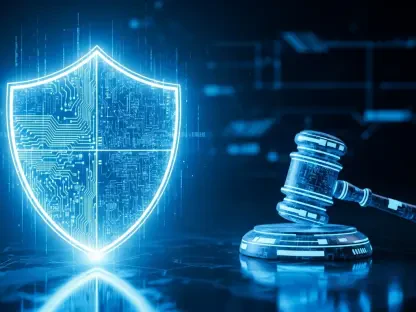Desiree Sainthrope, a renowned legal expert in global compliance and intellectual property, shares her insights into the dynamic landscape of cybersecurity regulations in the United States. Her extensive expertise in drafting and analyzing trade agreements provides her with a unique perspective on the implications of evolving technologies like AI. In this interview, we delve into the significant regulations poised to impact businesses, particularly focusing on the Cyber Incident Reporting for Critical Infrastructure Act (CIRCIA), proposed updates to HIPAA, and the role of the SEC in cybersecurity risk management.
What are the potential consequences for businesses that fail to comply with cyber regulations in the United States?
Failing to comply with cyber regulations in the U.S. can lead to severe repercussions for businesses. Financial penalties are a significant risk, but there are also potential legal actions to consider. Beyond the financial aspects, non-compliance can cause irreparable reputational damage, especially if a breach results in the exposure of sensitive or confidential information. Such outcomes can shake consumer trust and loyalty, impacting a company’s market position in the long run.
Could you explain the Cyber Incident Reporting for Critical Infrastructure Act (CIRCIA) and its significance?
The Cyber Incident Reporting for Critical Infrastructure Act (CIRCIA) is a crucial piece of legislation intended to bolster the cybersecurity posture of critical infrastructure sectors. By mandating the reporting of substantial cyber incidents within 72 hours and ransomware payments within 24 hours, it aims to enhance the early detection and coordination of responses to cyber threats. This act underscores the importance of timely information sharing and is designed to help prevent widespread damage by enabling quicker, more effective responses.
What are the mandatory reporting requirements proposed under CIRCIA for cyber incidents?
Under CIRCIA, covered entities must report substantial cyber incidents to the Cybersecurity and Infrastructure Security Agency (CISA) within 72 hours of occurrence. Additionally, any ransomware payments must be reported within 24 hours. These requirements are intended to facilitate a quicker national response to cyber threats and mitigate potential harm by leveraging the expertise and resources at CISA.
How is CISA involved in the process of encouraging the voluntary sharing of information?
CISA plays a pivotal role by encouraging entities to voluntarily share information about cyber threats and vulnerabilities, even before mandatory reporting under CIRCIA becomes obligatory. By fostering a culture of collaboration and transparency, CISA helps entities prepare for compliance and ensures that they are better equipped to manage and respond to cyber incidents proactively.
Can you provide an estimate of how many entities will be impacted by CIRCIA and what responsibilities they will have with regards to compliance?
It is estimated that more than 300,000 entities will fall under CIRCIA’s purview. These entities will be responsible for adhering to the new mandatory reporting requirements, which means they must have systems in place to quickly identify, assess, and report qualifying cyber incidents and ransomware payments within the stipulated time frames. This will likely mean updates to current cybersecurity infrastructure and processes.
What is the anticipated timeline for the finalization and implementation of the CIRCIA rule?
The finalization of the CIRCIA rule is anticipated to occur in 2025, with the regulation expected to take effect in 2026. This timeline sets a clear deadline for businesses to start revamping their cybersecurity protocols and ensures they are aligned with the new requirements before enforcement begins.
How should companies prepare for CIRCIA compliance as the rule is likely to be finalized in 2025?
Companies should begin by conducting thorough assessments of their current cybersecurity frameworks to identify any gaps in meeting CIRCIA’s proposed requirements. Investing in early adjustments, such as implementing robust incident detection and reporting systems, can ease the transition once the rule is finalized. Training staff to recognize and respond to potential cyber threats is also crucial.
What updates are being proposed by the US Department of Health and Human Services in relation to HIPAA?
The Department of Health and Human Services has proposed updates to HIPAA to address the increasing frequency of cyberattacks in the healthcare sector. These updates aim to enhance cybersecurity standards for protecting electronic protected health information (ePHI) and ensure that healthcare entities have effective measures in place to safeguard sensitive data.
Why are these HIPAA updates necessary, and what specific type of data does ePHI include?
The updates are necessary due to the rising number of cyberattacks targeting healthcare data, which contain sensitive information such as health conditions, treatments, and payment data. ePHI encompasses all electronic health data, and securing it is vital to maintaining the confidentiality and integrity of patient information. These updates are designed to strengthen defenses and ensure resilience against cyber threats.
What measures should healthcare entities take under the proposed HIPAA updates to ensure compliance?
Healthcare entities should assess their current cybersecurity strategies for potential vulnerabilities and update them according to the proposed guidelines. This includes implementing sophisticated security measures, such as encryption and multi-factor authentication, and regularly training staff on data protection practices to ensure they understand their role in safeguarding ePHI.
What is the role of the US Securities and Exchange Commission in shaping cybersecurity risk management requirements?
The US Securities and Exchange Commission (SEC) plays a crucial role in establishing cybersecurity risk management practices for public companies. The SEC’s rules demand that these companies not only report material cybersecurity incidents but also disclose their risk management plans in annual reports. This promotes transparency and ensures that companies are actively managing potential risks.
How are public companies affected by the SEC’s cybersecurity risk management rules, specifically regarding reporting requirements?
Public companies are required to report any material cybersecurity incidents and outline their cyber risk management strategies in their annual reports. These disclosures must be comprehensive, reflecting both current vulnerabilities and the measures being implemented to address them. This mandate is designed to keep investors informed and ensure companies remain vigilant.
Why are the SEC’s rules subject to criticism at hearings in the US House of Representatives?
The SEC’s rules have faced criticism in the US House of Representatives primarily due to concerns about their potential overreach and the burdens they impose on public companies. Some argue that the rules could be too prescriptive, imposing significant compliance costs without necessarily improving cybersecurity outcomes. This ongoing debate highlights the balancing act between regulation and corporate autonomy.
Are there any potential changes expected for the SEC rules, and how can businesses keep track of these changes?
While it remains uncertain if substantial changes will be made to the SEC’s rules, businesses should remain vigilant by closely monitoring announcements from the SEC and relevant trade publications. Engaging with legal counsel familiar with cybersecurity regulations can also provide businesses with timely insights and strategies for compliance.
What challenges do businesses face with these upcoming changes in cyber regulations, and how might they anticipate and prepare for compliance?
Businesses will face challenges such as updating their cybersecurity infrastructure, retraining staff, and ensuring they have the required legal frameworks in place to comply with new regulations. By proactively engaging with legal experts, investing in technology solutions, and fostering a culture of compliance, companies can better anticipate and address these challenges.
How can businesses begin monitoring these evolving rules to identify additional compliance measures needed for the future?
Companies should establish a continuous monitoring process, perhaps by designating a compliance officer or team, to stay informed about emerging regulations. Attending industry conferences, subscribing to relevant newsletters, and maintaining an open dialogue with industry peers are effective strategies to ensure that necessary adjustments are identified and implemented promptly.
Do you have any advice for our readers?
Remain proactive and informed. Cyber regulations are evolving, and staying ahead means investing in compliance now rather than reacting to changes later. By fostering a strong security culture and maintaining flexibility, businesses can navigate this complex regulatory landscape more effectively.









